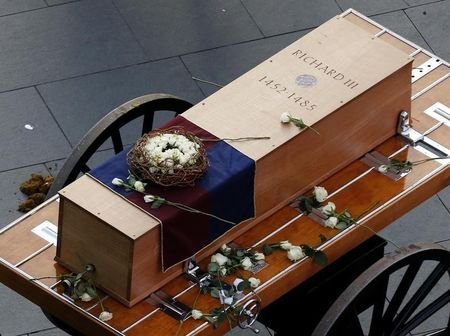 England’s slain King Richard III, exhumed from an undignified grave under a car park, was finally buried with honor today, 530 years after his death on the battlefield.
England’s slain King Richard III, exhumed from an undignified grave under a car park, was finally buried with honor today, 530 years after his death on the battlefield.
In a ceremony filled with pageantry and poignancy, a coffin containing his bones were lowered into the ground at Leicester Cathedral in central England as thousands of well-wishers gathered outside.
“We return the bones of your servant Richard to the grave,” Archbishop of Canterbury Justin Welby, the spiritual leader of the Church of England, said in a prayer.
Many of those outside the cathedral, which was draped in Richard’s personal standard, were clutching white roses, the symbol of the former king’s House of York dynasty.
“I feel he was badly treated at the time of his death and all through history,” said May Doherty, a 62-year-old pensioner from Coleraine in Northern Ireland who was dressed in full medieval costume.
“We believe he was innocent and this is the burial he deserved. This is a once in a lifetime occasion. It’s brilliant to be here and be part of history.”
The last English king to die in battle, Richard will now lie in a new tomb inside the cathedral, across the street from where his remains were located in 2012.
After the coffin was lowered into the grave by six soldiers in uniform, Oscar-nominated actor Benedict Cumberbatch read a specially-commissioned work by the Poet Laureate Carol Ann Duffy.
Cumberbatch, who is due to play Richard in an upcoming BBC television series, is also the king’s third cousin 16 times removed.
Identified by his DNA, radiocarbon dating and his distinctive curved spine, the discovery of Richard’s skeleton has triggered a revival of interest in his reign.
The last of the Plantagenet dynasty, Richard ruled from 1483 until his death at the Battle of Bosworth near Leicester in 1485.
It was the last major conflict in the Wars of the Roses and changed the course of English history.
Richard’s defeat saw the crown pass from the Plantagenets to the Tudors, with his victorious opponent ending the blood-soaked day as king Henry VII.
Richard was hastily buried with minimal ceremony in Greyfriars monastery, which was dissolved by Henry VIII in 1538.
His exhumation has encouraged scholars to look again at his record of social reform, rather than rely on William Shakespeare’s Tudor-era portrayal of him as a scheming murderer.
Richard’s closest living relatives, all direct female line descendants of his eldest sister Anne of York, were at the service.

